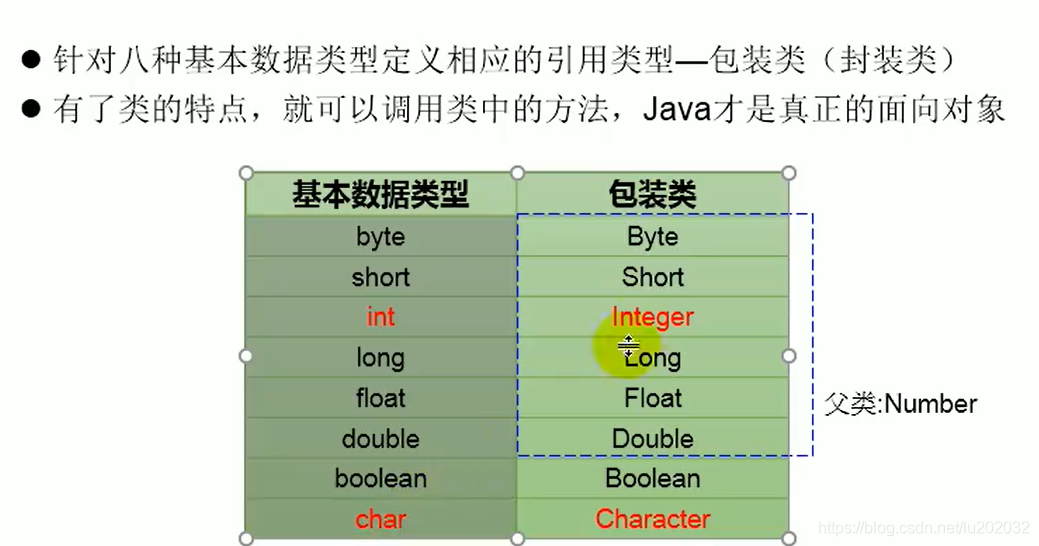博主前些天发现了一个巨牛的人工智能学习网站,通俗易懂,风趣幽默,忍不住也分享一下给大家,
👉点击跳转到网站
包装类的使用:
1.java提供了8种基本数据类型的封装类,使得基本数据类型的变量具有了类的特征。
图解如下:

2.要点:掌握基本数据类型,包装类,String三者之间的转换。
2.1 基本数据类型—>包装类:调用包装类的适配器。装箱
Example:
public class WarpperTest {
public static void main(String[] args) {
int i=10;
Integer in1=new Integer(i);
Integer integer2 = Integer.valueOf(i);
// System.out.println(i.toString); //报异常
System.out.println(in1.toString()); //10
Boolean b=new Boolean("TRue");
System.out.println(b); //true
}
}
2.2 包装类—>转换为基本数据类型,基本数据类型XXX调用XXXValue()方法。 拆箱
Example:
Integer a=new Integer(10);
int c = a.intValue();
System.out.println(c+1);//11
Boolean d = new Boolean("R");
boolean e = d.booleanValue();
System.out.println(e+"u");//falseu
Float f=new Float("15.2");
float g=f.floatValue();
System.out.println(g+1);//16.2
2.3.JDK5.0 新特性:自动装箱,自动拆箱
Example:
//自动装箱
int h=5;
Integer y=h; //底层使用的是Integer.valueOf(h)
boolean r=true;
Boolean r1=r;
//自动拆箱
System.out.println(y.toString());
int x=y; //底层调用的是intValue()方法
boolean r2=r1;
2.4.基本数据类型,包装类—>String类型
public class DayTest {
public static void main(String[] args) {
int a=10;
boolean b=true;
//方式1:连接运算符
System.out.println(a+"");
System.out.println(b+"");
//方式2:调用String的valueOf(XXX xxx)
int c=11;
String c1=String.valueOf(c);
boolean d=true;
String d1=String.valueOf(d);
System.out.println(d1+a);
float e=15.6f;
String e1=String.valueOf(e);
System.out.println(e1);
}
}
2.5. String类型–>包装类,基本数据类型
String f="123";
int f1=Integer.parseInt(f);
System.out.println(f1);
//报异常
/* String h="123你好";
int h1=Integer.parseInt(h);
System.out.println(h1);*/
String q="true1";
boolean q1=Boolean.parseBoolean(q);
System.out.println(q1); //输出false
包装类Integer和Character的常用方法如下:
public class WrapperMethod {
public static void main(String[] args) {
System.out.println(Integer.MAX_VALUE);//最大值
System.out.println(Integer.MIN_VALUE); //最小值
System.out.println(Character.isDigit('1'));//判断是不是数字
System.out.println(Character.isLetter('a'));//判断是不是字母
System.out.println(Character.isUpperCase('a'));//判断是不是大写
System.out.println(Character.isLowerCase('a'));//判断是不是小写
System.out.println(Character.isWhitespace('a')); //判断是不是空格
System.out.println(Character.toUpperCase('a')); //转成大写
System.out.println(Character.toLowerCase('A'));//转成小写
}
}
输出结果如下:
2147483647
-2147483648
true
true
false
true
false
A
a
Integer的创建机制如下,具体注释已经在代码中给出:
public class WrapperExercise {
public static void main(String[] args) {
Integer i = new Integer(1);
Integer j = new Integer(1);
System.out.println(i == j); //false
//这里主要看范围-128~127 就是直接返回,否则就要new Integer(i)
/*
解读:
1、如果i在IntegerCache.low(-128)到IntegerCache.high(127),就直接从数组返回
2、如果不在-128~127,就直接new Integer(i)
public static Integer valueOf(int i) {
if (i >= IntegerCache.low && i <= IntegerCache.high)
return IntegerCache.cache[i + (-IntegerCache.low)];
return new Integer(i);
}
*/
Integer m = 1; //底层Integer.valueOf(1) ->阅读源码
Integer n = 1;
System.out.println(m == n); //true
Integer x = 128;
Integer y = 128;
System.out.println(x == y); //false
}
}
Integer面试题的详解
public class WrapperExercise02 {
public static void main(String[] args) {
Integer i1 = new Integer(127);
Integer i2 = new Integer(127);
System.out.println(i1 == i2); //false
Integer i3 = new Integer(128);
Integer i4 = new Integer(128);
System.out.println(i3 == i4); //false
Integer i5 = 127;
Integer i6 = 127;
System.out.println(i5 == i6); //true
Integer i7 = 128;
Integer i8 = 128;
System.out.println(i7 == i8); //false
Integer i9 = 127;
Integer i10 = new Integer(127);
//i9 是从数组中取出的 而i10是new 出来的 所以不是同一个对象
System.out.println(i9 == i10); //false
Integer i11 = 127;
int i12 = 127;
//只要有基本数据类型,判断的是值是否相同
System.out.println(i11 == i12);//true
Integer i13 = 128;
int i14 = 128;
System.out.println(i13 == i14);//true
}
}
以上是包装类的详解,供大家参考学习,有不当之处,可在评论区指正!
























 4064
4064











 被折叠的 条评论
为什么被折叠?
被折叠的 条评论
为什么被折叠?










